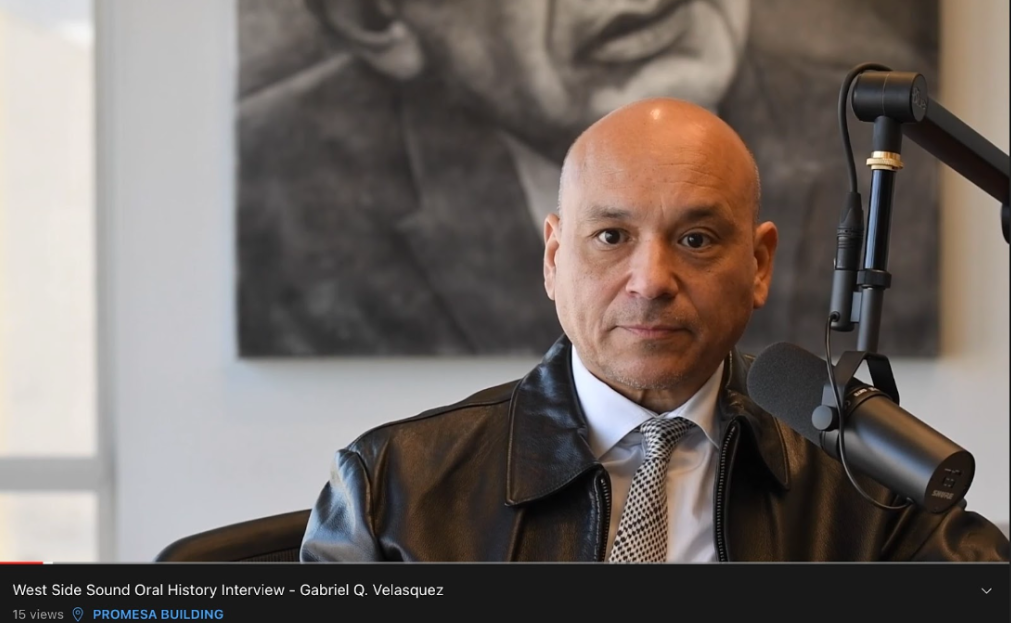
The West Side Sound Oral History Project is a collaborative effort that stemmed from the application for a seed grant from the UTSA Westside Community Partnerships Faculty Seed Grants. The grant program serves with the intention of projects that are “likely to catalyze and support meaningful community and academic engagement across research spectrum to improve bienestar of WCP [Westside Community Partnerships] residents.” The project collects oral history interviews with community members, musicians, DJs, and music enthusiasts that were/are a part of this music genre scene. West Side Sound is a genre of music that was largely influenced by a combination of Black music like R&B & rock ‘n’ roll and conjunto, country, and western music but was performed by San Antonio’s West and East Side communities. This project’s objective is to document the history of West Side Sound through the historical memory, and experiential knowledge of the interviewees who participate. The main goal of the West Side Sound Oral History Project is to document the oral recollections of musical minds, musicians, and community members of West Side Sound.
Geremy’s tasks for the project included photography at the showcase event, teaching the team how to use special photography equipment if asked, developing several interview questions, sending out meeting invites for each group meeting, and completing and uploading six interviews. In the end, he led 7 out of the total 13 interviews completed by the group. His interview subjects were Rosa Guzman, Chuco Garcia, Rambo Salinas, Richard Herrera, Patti Elizondo, Eva Ybarra, and Gabriel Velasquez. Along with Dr. Mendoza and himself, the project team included Dr. Gloria Gonzales, Lecturer in the Department of Race, Ethnicity, Gender, and Sexuality Studies, and Jaime Macias, community member, and owner of a local bar, Jaime’s Place. The core group met bi-weekly to discuss interviewee selection, questions to be asked, locations for interviews, and budget questions. Each team member took an active part in the discussions and planning of the project. Geremy conducted 7 of the 13 total interviews conducted throughout the project utilizing the project standards set during the initial meetings. This includes things such as video orientation, camera setup, questions asked, microphone placement, background setup, and other expected setup parameters.
The interviews each consisted of some background information about the interviewee, verbal consent to be interviewed, contextual questions about the West Side Sound, and final thoughts for viewers. These questions were originally posed by Dr. Sylvia Mendoza and each group member adjusted the questions based on each interview. Aside from those questions, each interviewer asked general questions that helped the conversation move along. If an interviewee was visually uncomfortable or unable to answer a question, the goal was to redirect and ask the same question in a way that was understandable, or to change to another question altogether. Each interview is only being stored on YouTube preliminarily until the files are uploaded to the UTSA Special Collections. Listing the videos on YouTube allowed the interviewee to preview their interview before publishing it to the public, and it also allowed the group to review the interviews as well. The interview descriptions include the interviewer, interviewee, the location of the interview, the date and time of the interview, and the topic.
A goal set early on by the group was to showcase the project at a community event. A member of Geremy’s core group, Jaime Macias, is the owner of Jaime’s Place, a local bar and community venue that hosts events regarding politics, music, community growth, etc. The team immediately knew that this community event had to be at the location of their community partner’s business. He also created a map with Google Earth that showcases some of the locations mentioned in these interviews. The process of interviewing and publishing these interviews provided us and future researchers with a great deal of knowledge and insight into the West Side Sound and the West Side of San Antonio in general. The ability of a community to continue to grow without constant investment shows viewers a type of tenacity and self-preservation that can only come through experiences like those of individuals rooted in history and shared values. While West Side Sound is certainly not known to all, it is growing in popularity. This is even more cause for concern and research by scholars in fields relative to the genre and development of communities, music, Mexican American Studies programs, and other similar programs.
You can listen to the oral histories here.
